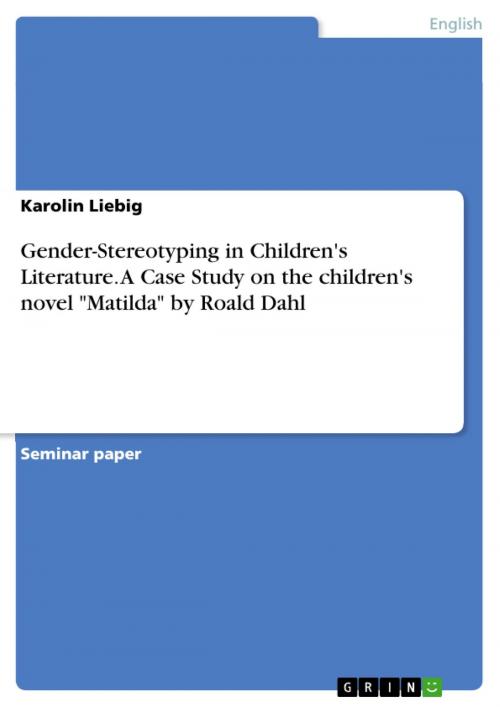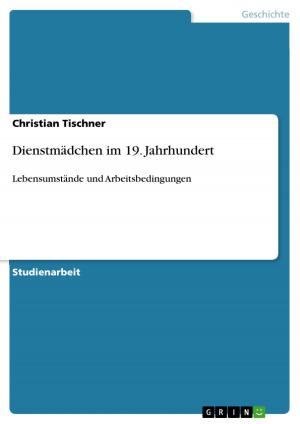Gender-Stereotyping in Children's Literature. A Case Study on the children's novel 'Matilda' by Roald Dahl
Fiction & Literature, Literary Theory & Criticism, British| Author: | Karolin Liebig | ISBN: | 9783668223882 |
| Publisher: | GRIN Verlag | Publication: | May 23, 2016 |
| Imprint: | GRIN Verlag | Language: | English |
| Author: | Karolin Liebig |
| ISBN: | 9783668223882 |
| Publisher: | GRIN Verlag |
| Publication: | May 23, 2016 |
| Imprint: | GRIN Verlag |
| Language: | English |
Seminar paper from the year 2015 in the subject English Language and Literature Studies - Literature, grade: 3,0, University of Erfurt (Anglistik/Amerikanistik), course: Language and Gender, language: English, abstract: This study examines the language use towards male and female characters in the children's novel 'Matilda' written by Roald Dahl. The fact of an uneven depiction of female and male characters in children's literature, which is proved in many studies, is the base of this analysis. With this work I examine if Dahl uses gender stereotyped language in his popular novel as well. The selection of this book has a personal background. When I was an Au pair in Australia an audiobook with all stories of Roald Dahl fell into my hands. The owner, a boy, said I should definitely listen to those because they are 'awesome'. For this kind of study I thought Matilda might be interesting because the protagonist is a girl. The main emphasis of the analysis is put on the number of characters and their occupation, the used adjectives to describe the characters, and the verbs describing the characters' actions. That leads to the following hypotheses: Firstly, female characters are underrepresented in extensive roles; secondly, male characters are depicted in more different occupations than female characters; thirdly, different adjectives are used to describe female and male characters; and finally, female characters are portrayed predominantly in gender-stereotyped activities. The overall interest of this work is if the characters in this children's novel are mainly described in a gender-stereotyped way. My work is structured as follows: I will provide a rough introduction in Gender studies and especially in the field of Gender and Language in the first chapter. Further I point out the central matters of the research in Gender and Children's literature and introduce a few studies that support my own examination and are the basis for the hypotheses. The first part in the second chapter gives an introduction to the sample book as well as the author. The second point describes the procedure of the research, the consistence of the data and how it is collected. How the data is arranged for the analysis is to be found in the third part of chapter two. The third chapter starts with the analysis of the occurring characters and their occupations, followed by an analysis of the adjectives to find out if the author uses gender stereotyped words to describe female and male characters. In the fourth part of this chapter the verbs are examined for gender stereotyping female characters. The conclusion sums up the work and gives a prospect of further questions.
Ich habe an der Universität Jena Kunsthistorik und Sprechwissenschaft studiert. An der Universität Erfurt studierte ich Primare und elementare Bildung sowie Anglistik. Beide Studien habe ich mit dem Bachelor of Arts abgeschlossen.
Seminar paper from the year 2015 in the subject English Language and Literature Studies - Literature, grade: 3,0, University of Erfurt (Anglistik/Amerikanistik), course: Language and Gender, language: English, abstract: This study examines the language use towards male and female characters in the children's novel 'Matilda' written by Roald Dahl. The fact of an uneven depiction of female and male characters in children's literature, which is proved in many studies, is the base of this analysis. With this work I examine if Dahl uses gender stereotyped language in his popular novel as well. The selection of this book has a personal background. When I was an Au pair in Australia an audiobook with all stories of Roald Dahl fell into my hands. The owner, a boy, said I should definitely listen to those because they are 'awesome'. For this kind of study I thought Matilda might be interesting because the protagonist is a girl. The main emphasis of the analysis is put on the number of characters and their occupation, the used adjectives to describe the characters, and the verbs describing the characters' actions. That leads to the following hypotheses: Firstly, female characters are underrepresented in extensive roles; secondly, male characters are depicted in more different occupations than female characters; thirdly, different adjectives are used to describe female and male characters; and finally, female characters are portrayed predominantly in gender-stereotyped activities. The overall interest of this work is if the characters in this children's novel are mainly described in a gender-stereotyped way. My work is structured as follows: I will provide a rough introduction in Gender studies and especially in the field of Gender and Language in the first chapter. Further I point out the central matters of the research in Gender and Children's literature and introduce a few studies that support my own examination and are the basis for the hypotheses. The first part in the second chapter gives an introduction to the sample book as well as the author. The second point describes the procedure of the research, the consistence of the data and how it is collected. How the data is arranged for the analysis is to be found in the third part of chapter two. The third chapter starts with the analysis of the occurring characters and their occupations, followed by an analysis of the adjectives to find out if the author uses gender stereotyped words to describe female and male characters. In the fourth part of this chapter the verbs are examined for gender stereotyping female characters. The conclusion sums up the work and gives a prospect of further questions.
Ich habe an der Universität Jena Kunsthistorik und Sprechwissenschaft studiert. An der Universität Erfurt studierte ich Primare und elementare Bildung sowie Anglistik. Beide Studien habe ich mit dem Bachelor of Arts abgeschlossen.















